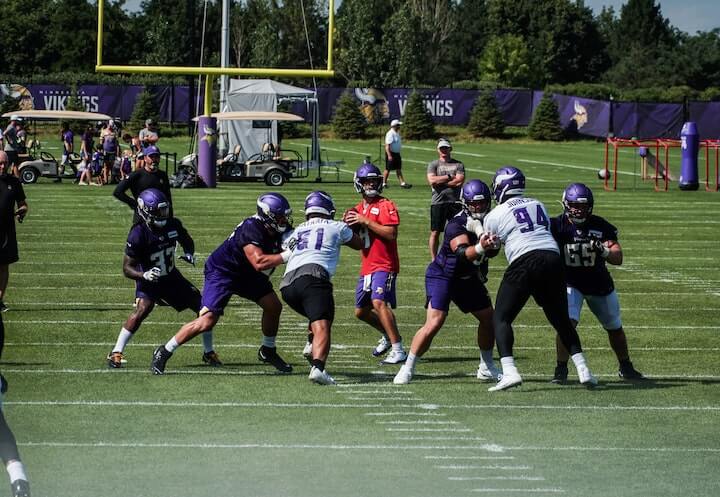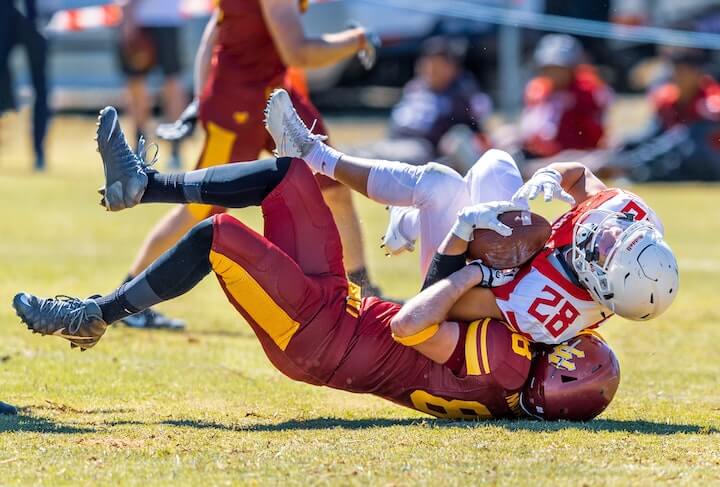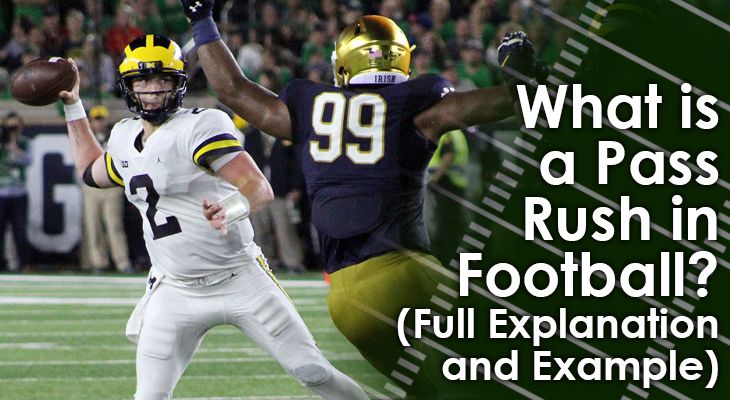A pass rush is the attempt by the defensive team to get players to the quarterback and disrupt a pass attempt.
The defensive team has two goals when they execute a pass rush.
The first is to get to the quarterback before the throw (also know as sacking)
If they can't force a sack, their other goal is to put pressure on the quarterback and force a mistake.
Every defensive team in football will utilize a pass rush of some sort on every single passing play.
The difference comes in the execution of the play and which players will be rushing the quarterback.
Let's take a look at why the defense executes it, and the different types of pass rushes.

Why Do a Pass Rush
No matter what the outcome of the play, the basis for a pass rush is the same:
To cause disruption.
There are four main outcomes that a defense hopes for when executing a pass rush:
1. Sack
This happens when a defensive player tackles the quarterback before they get to throw the ball - usually resulting in a huge yardage loss.
2. Turnover
This happens in one of two ways.
The first is if a defensive player is able to hit the quarterback and knock the ball loose before they throw it for a fumble.
The second is if a defender intercepts the pass of the quarterback.
The interception could occur because of a deflected pass or the fact that he's forced to throw the ball earlier than he wanted to.
3. Incomplete Pass
If the defense can't force a sack or a turnover, the next best thing would be an incomplete pass.
The pass rush could force the quarterback to roll out of the pocket, for example, and throw a pass that is off target.
4. QB Running Attempt
When quarterbacks feel the pressure and can't find an open receiver, they may tuck the ball down and try to run it themselves.
If the quarterback isn't very mobile, this could be good news for the defense, as it's likely the quarterback won't gain many yards at all.
There are, of course, times when the pass rush isn't successful at forcing those outcomes.
But, the ultimate goal is for one of those four things to happen when a defense executes a pass rush.

Who Rushes the Quarterback in Base Defenses?
In standard defensive calls, every defensive lineman will have to rush the quarterback.
In a 4-3 base defense, this means both defensive tackles and both defensive ends will also be rushing the quarterback.
In a 3-4 alignment, the two defensive ends and nose tackle will be the ones to rush the quarterback.
For these base defensive calls, all the other players on the field will drop into pass coverage.
They will cover receivers only, leaving all the pressure in the backfield up to the defensive linemen.
Defensive coaches will often go this route on third downs with the offensive needing to gain a lot of yards.
For instance, on 3rd-and-22, the defensive coach will usually look to play it safer and choose to rush with just the defensive linemen.
That beefs up the pass coverage on that play, even if it sacrifices a pass rush in the process.
In either of these defensive alignments, there will be more offensive linemen (at least five) than there will be defensive linemen (either three or four).
This gives the numbers advantage to the offense.
Still, there are some great defensive linemen who can break through this advantage to put pressure on the quarterback.

Who Rushes the Quarterback in Blitzes?
When the defensive coaches want to bring extra pressure on the quarterback, they will call a blitz.
On these plays, at least one other player will join the defensive linemen in rushing the quarterback.
There are three main blitz types - with one additional wrinkle defensive coaches can call for more advanced teams
1. Linebacker Blitz
This is perhaps the most common blitz package.
At least one linebacker will help rush the quarterback in this scenario.
Defensive coaches can bring pressure from the outside with either the Sam or Will linebacker (or both).
They can also choose to bring inside pressure with the Mike linebacker.
2. Cornerback Blitz
For a surprise attack, the defensive coach can ask a cornerback to rush the quarterback.
The cornerback lines up at the usual position opposite a receiver, and then break off and rush the quarterback at the snap.
In this case, the cornerback's job is to get in the face of the quarterback more so than it is to make a sack.
3. Safety Blitz
The safety blitz is similar to a linebacker blitz, except it's more hidden.
Either the free safety or strong safety will line up a little closer to the line of scrimmage than normal.
They will then provide extra pressure either up the middle or to the outside on a rush.
It's more hidden because it'll be harder for offensive linemen and quarterbacks to see safeties before the snap.
4. Drop in Coverage
The wrinkle more advanced defensive coaches can use.
It involves dropping a defensive linemen into coverage.
In this blitz, an outside linebacker will rush the quarterback, taking the place of a defensive end.
In return, the defensive end on that side of the field will drop back into pass coverage.
The defensive end will be responsible for picking up the receiver that the rushing outside linebacker would normally cover.
Again, this is quite complicated, so it's usually reserved for more advanced teams.
Conclusion
A basic pass rush happens on every passing play in football.
All defensive linemen will rush the quarterback to try to disrupt the offense's game plan.
Their hope is to create a sack, cause a turnover, or force the quarterback to make some other mistake.
When defensive coaches want to bring extra pressure on the quarterback, they will call a blitz.
The blitz can come in different formations, utilizing different players such as linebackers, cornerbacks or safeties to rush the quarterback along with the defensive linemen.

